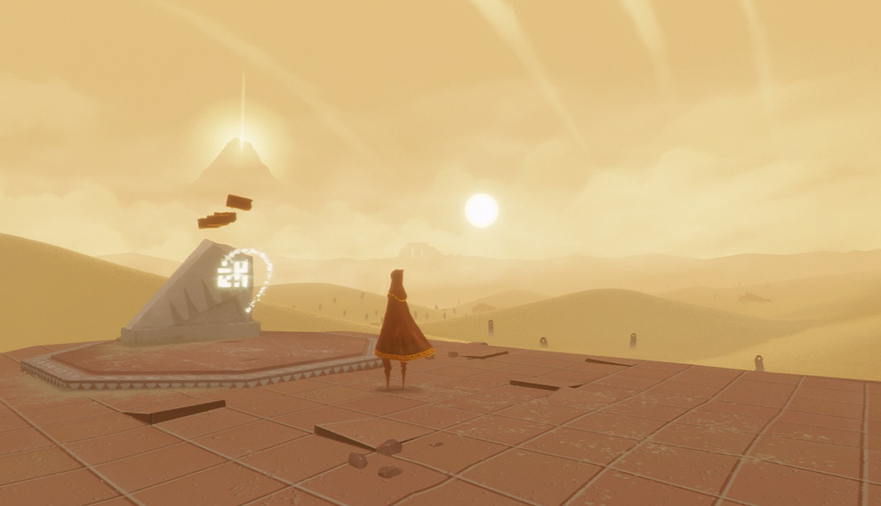To those who ask if there exists a video game worthy of being considered art, Cosmic Flypaper has a one-word answer:
If all of the video games released in 2012 were put on display like paintings in an art gallery, Journey is the exhibit that would turn the most heads, shining brightly amidst the slush of browns that dominate much of the triple-A titles that muscle the most publicity. Singing praise of Journey’s dazzling range of color and drooling over the graphics that make it all possible in comparison to the likes of Call of Duty would only be on the level of admiring the Mona Lisa for being a portrait of a woman who smiles instead of looking so serious all the time, however – after all, other franchise favorites like Halo and Assassin’s Creed have begun to show that industry heavyweights are not afraid to explore beyond the grim and gritty palette of war after all. Where Journey deserves every bit of praise it has received is when you stop for a moment in that gallery to take in the perfectly balanced aesthetics of the game – how its art style complements the musical score crafted by Austin Wintory that’s sure to become a staple of future Video Games Live performances (not to mention what could be an incredible milestone for video game music next month), how the sprinkle of dynamic sound effects (many of which are generated by the player’s actions) shade in anything conceivably missing in between the lines, and how the mechanics of the game all work in harmony to capture your attention and win your admiration – all with the gentle warmth of a peaceful campfire. Not a single grain of glittering sand or stroke of the violin is in the game just for show or just to set the mood – every piece has been carefully hand-woven together as a mystical fabric that only true artists can craft, and it’s no coincidence that you begin to discover this as soon as you find the scarf that empowers your character to jump and glide after taking the first few steps toward the mountain ahead.
While many other video games rely on exposition dumps through either text or cut-scenes performed by voice actors to inform the player of their goals or give them some sense of how they should think and feel as a character, Journey eschews the use of dialogue and pulls off a feat that poetry, music, and other forms of artistic expression have long been revered for: leaving the story wide open to interpretation, allowing players to construct their own narrative around the experience from beginning to end. Certain archetypes players encounter along the way might call certain common themes to mind, but overall, if asked how this game makes you feel and what playing through it meant to you, no two players will have the same answer.
There are tons of other video games out there that will make you feel like you are taking control of characters from your favorite movie, TV show, cartoon, or animé, but Journey grants the wish of video game lovers everywhere from 1996 – you get to be Mario in Super Mario 64 and jump straight through a painting into a vibrant new world. For the full effect, play Journey alone at night with the lights off and with your speakers cranked up. This sort of advice is typical for survivor horror fare like Silent Hill, but trust me — playing Journey wrapped in the warm shroud of the night will give you chills, not out of fright, but out of its raw, yet unassuming power to resonate with you on both a conscious and innate level.
Now be warned: I won’t be revealing how the game ends in this review, but I will be talking about certain aesthetics and mechanics that become very important near the end of the game, so if you’re planning on going in cold sometime to experience everything this game has to offer, pause here, take the three hours to complete the game, and come right back. Don’t worry – I’ll wait.
Above all else, what makes Journey a transcendent work of art is its use of anonymous cooperative multiplayer. Finding a decent adventure game with cooperative multiplayer is a cinch, but try finding a decent adventure game with cooperative multiplayer that is strictly non-combat. thatgamecompany meets that challenge and ups the ante even further by stripping away the ability to communicate verbally with your nameless companion to allow the magic of the game’s aesthetic to create the bond between you and that person. If you knew nothing whatsoever about the game going in, you might have assumed that the mysterious cloaked figure resembling your own character that you encounter after passing through the first gate is a computer-controlled NPC (non-playable character). It is not until the end of the game when it’s revealed that that other character was a real person playing with you all along – and on top of that, there’s a good chance that it was not just one person, but SEVERAL different people that you courageously banded together with to battle the elements along the way.
What makes this anonymous collaboration so compelling? Well, when you obtain your mystical scarf at the beginning of the game, you’ll gain the ability to jump and glide, but that power is completely dependent upon how long your scarf is and how much it is “charged up” (for lack of better phrase). You’ll soon discover that to “charge up” your jumping and gliding ability, you have to call out and absorb spiritual energy from the fabric that matches your scarf that seems to grow naturally in the environment that surrounds you …or, when you meet another player, you can gather that energy simply by making contact with him/her. When you come into contact with this mysterious companion, they not only restore some of your power, but you restore some of theirs at the same time. As you near the game’s conclusion, this deceptively simple mechanic that you might have brushed off in the early stages of the game packs an astounding emotional punch as you quickly realize how much of a struggle it becomes to traverse certain terrain and navigate your way around without sticking close to your companion. It’s not impossible to traverse the landscape by going it alone, but I challenge you to do so without feeling compelled to slow down and check on the status of your companion at least once.
The only major flaw for this game is that it is only available on the Playstation 3. When starting out, thatgamecompany made a deal with Sony to produce three games that would be exclusive to their console, and so that’s why you won’t see it anywhere else. It’s a shame since how this work of art deserves to be shared with anyone who owns a device capable of playing video games in a quiet space at home (I wouldn’t recommend playing this on a mobile device if it was available that way since it would distract from the experience playing it on the go), but with Journey being the final game in this three-game exclusivity deal and with all the well-deserved attention it’s getting, hopefully the next trick thatgamecompany has up its sleeve will go multiplatform.

















Trackbacks/Pingbacks